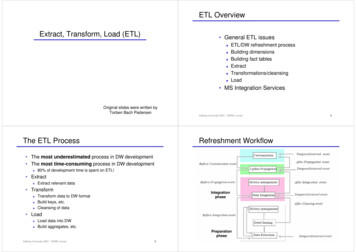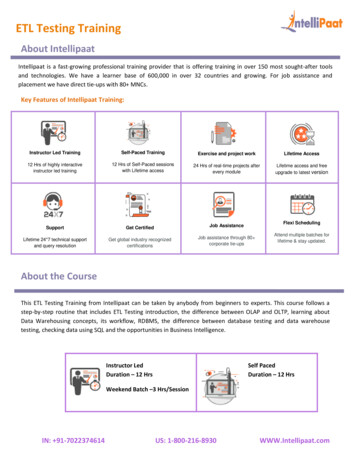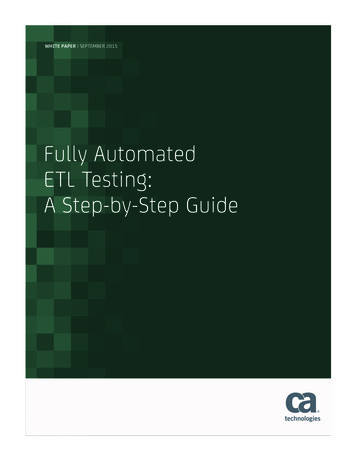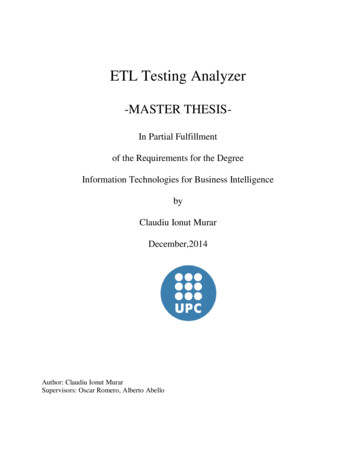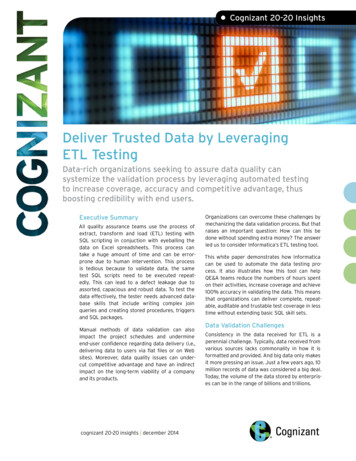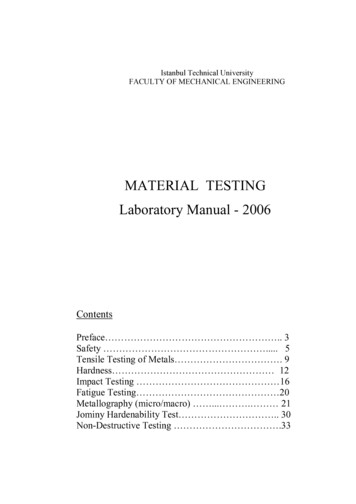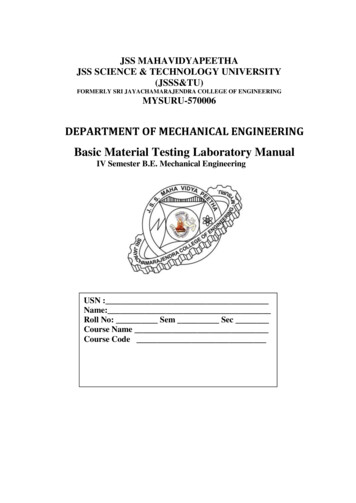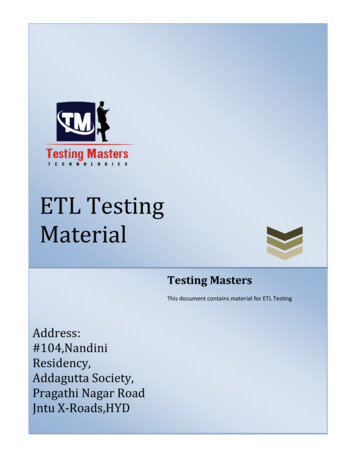
Transcription
ETL TestingMaterialTesting MastersThis document contains material for ETL TestingAddress:#104,NandiniResidency,Addagutta Society,Pragathi Nagar RoadJntu X-Roads,HYD
ETL TestingIndex1. Basics:Need for Data WarehousingWhat isDataWarehousing?Concepts of OLTP and OLAPDifference betweenDatabase and Data Warehousing2. DataWarehousing Concepts Data Models Conceptual Data Model Logical Data Model Physical Data Model Data Schemaso Star Schemao Snow Flake Schema SCD 1,2 and 3 types Normalization3. Business Intelligence4. SQL Basics DDL Commands DML commands DQL Command with Clauses Joins Functions Cursors Procedures5. Overview of ETL tools age # 2
ETL Testing6. Transformations in ETL Sample Load from Source to Target Joiner Transformation Derived columnTransformation Lookup Transformation Union Transformation Sorter Transformation Conditional Split Transformation Script component7. Introduction to ETL Testing8. ETL Testing Concepts Requirements Gathering High Level Design Low level Design Development Unit Testing Integration Testing Test cases preparation9. Types of ETL Testing10. ETL Testing Defects11. Defects .comPage # 3
ETL estingmasters.comPage # 4
ETL TestingChapter 1 – Data warehousing Basics:1.1 Need for Data WarehousingEvery Organization is in need of maintaining the data. The means of maintaining data can be differentmeans such as Books, tapes, excels. As time goes on changing, the affectivity of the data maintenanceand handling the data also started changing. Let’s think of handling data when there are more than 1000customers or employees in any organization and their data needs to be preserved to be handled in latertimes. All this has not proved successful until datawarehousing came in to place.In challenging times good decision-making becomes critical. The best decisions are made when all therelevant data available is taken into consideration. The best possible source for that data is a welldesigned data warehouse.Some Organizations are really small which cannot afford for an data warehouse. They can actually usedata marts which resembles the data warehouse where their transactional data is very low. Datawarehouse has become more efficient when handling data for larger organizations.1.2 What is Data Warehousing?Data warehousing combines data from multiple, variable sources into one database which can be easilymanipulated. This can be used for Analysis, Transformation and Reporting. Usually Larger companies usethis data warehousing for analyzing trends over a period of time for viewing transactional data and planaccordingly.Data warehouse is defined as subject oriented,Integrated,Time Variant and Non-Volatile collection ofdata for the management for decision making processing.Subject Oriented: Thisis used to analyze particular subject area.Integrated: This shows that integrates data from different comPage # 5
ETL TestingTime variant: Historical data is usually maintained in a Data warehouse, i.e. retrieval can be for anyperiod. This usually contrasts with the transactional system, in which only the most recent data ismaintained. But in the Data warehouse,the transactional data is moved periodically where the recentand the previous data is also maintained.Non-Volatile: Once the data is placed in the data warehouse,it cannot be altered,which means we willnever be able to alter the historical data.1.3 OLTP and OLAP:OLTP Online Transaction Processing SystemOLTP is nothing but a database which actually stores the daily transactions which is called as the currentdata. Usually OLTP is used for more of the online applications where the application needs to updatevery frequently in order to maintain consistency in the data.OLTP deals with the large number of data.OLAP Online Analytical Processing SystemOLAP deals with analyzing the data for Decision making and planning.This actually deals with theaggregations and the data in OLAP will be from different data sourcesCompared to OLTP, OLAP deals with relatively small amount of data.1.4 Difference between Database and Data warehouseDatabase: This can be treated as an OLTP system where it stores the data from the applications foruse.Small applications can run with a database.Data warehouse: This is accumulation of the all the data related to the application, It can be from theDatabase where the Transaction data resides, Flat files that are used,Legacy or Mainframe sources.Largeorganization will need a data warehouse where there is a need for analytics for decision omPage # 6
ETL TestingDatabaseData WarehouseDatabase has the current data which has a chanceof Updating day by day.Contains the Day to day operations data.Data warehouse Stores the Historical data where theaccuracy is maintained over period of time.Contains the Long term Operations data.Database professionals, agents access this particulardata.Managers, Analysts access the data warehouse dataData in the Database will always be in the form ofInput.Database is used for Transactions.Database has both Read/Write access.Data in the Data warehouse will always be the outputdata where it is used for Analyzing trends.Data warehouse is used for Analytics.Data warehouse has only the Read access.Database contains only few number of recordscompared to a Data warehouse.Database is always Normalized.Data warehouse contains millions of records as the DWHgets refreshed with historic data.Data warehouse is DenormalisedThe data view in the database will always beRelational.The data view in the Data warehouse id alwaysMultidimensionalDatabase contains the detailed data.Data warehouse contains the consolidated Page # 7
ETL Testing2 Data warehousing Concepts:2.1 Data Model: Data model tells how the logical structure of a database is modeled. Data Models arefundamental entities to introduce abstraction in DBMS. Data models define how data is connectedto each other and how it will be processed and stored inside the system.2.1.1 Conceptual DataModel:This usually pictures the highest level of relationshipbetweentheentities.a. Displays the important entities and the relationships among them.b. No attribute is specified.c. No primary key is s.comPage # 8
ETL Testing2.1.22.1.3Logical Data Model:This defines the data as much as possible, to show how they can bephysically implemented in the database.a. Displays all the entities and the attributes and the relationships between them.b. Primary key for each entity is specified.c. Foreign keys for each entity if exists is specified.d. Normalization is performed.Physical Data Model :This defineshow the model is physically existing in the systema. Displays all the tables and columns.b. Displays foreign keys.c. Displays lookup tables.d. Change the relationships into foreign keys.e. Entity now becomes table.f. Attribute now becomes columng. Datatypes are also shown in this mPage # 9
ETL TestingDifference between Conceptual, Logical, and Physical Data modelConceptualis just a high level representation of the Entities that were used as a part of DB design.Logical is the next level representation for a Conceptual design in which the entities and attributescomes into picture but with understandable English names. The Relationships are also defined.Physical is the more granular level of representing the DB design, in which the entities are nowrepresented as Tables and the attributes are represented as columns along with the primary and foreignkey relationships. By looking at the physical design, a person can develop the Database,which in othermeans can be called as the physical representation of the database.2.1.4 Dimensional Data Model:This defines the Data modeling technique by defining the schema (Star and Snowflake schema).2.2 Schema: A database schema defines its entities and the relationship among them. Database schemais a descriptive detail of the database, which can be depicted by means of schema diagrams. All theseactivities are done by database designer to help programmers in order to give some ease ofunderstanding all aspect of database.2.2.1 Star Schema: This consists of the fact table in the middle and the dimensional table around ge # 10
ETL TestingFact table is usually a sum of all the dimensions.Dimension table is a single entity.A primary key in adimension table is represented as a foreign key in a fact table.2.2.2Snowflake Schema: This is an extension of the Star Schema, where each point of a start isdivided into more granular level.Each Dimension table is still normalized into multiple lookup tables.The main advantage of thesnowflake schema is to improve the query performance due to minimized disk storage and joining canalso happen on smaller lookup tables.Disadvantage is maintenance efforts to manage the number of lookup omPage # 11
ETL Testing2.3 SCD Types:Slowly changing dimensions (SCD) determine how the historical changes in the dimension tables arehandled. Implementing the SCD mechanism enables users to know to which category an item belongedto in any given date.SCD is more particular to Data warehousing,where the record varies over time.Slowly ChangingDimensions are often categorized into three types namely Type1, Type2 and Type3.Ex: Consider a customer with name Rahul who is living in London from 2003.This can be depicted in atable as below:Customer Number1001Customer NameRahulYear2003LocationLondonType 1 SCD: Replaces the old entry with the new valueThe customer Rahul has moved from London to Paris in the year age # 12
ETL TestingIn this Type 1 SCD, the table will be changed as below:Customer Number1001Customer NameRahulYear2005LocationParisIn this case, the previous entry which is treated as history is lost.Type 2 SCD: Creates an New entry in the tableThe New record is inserted into the same table, In this Type 2 SCD, the table will be changed as below::Customer Number10011001Customer NameRahulRahulYear20032005LocationLondonParisIn this case, each record will be treated differently, which makes the table to grow fast and complicatesthe ETL process. This is mainly for tracking the historical changes.Type 3 SCD: Creating New Fields in the tableNew fields are added to the table to main the historyIn this Type 3 SCD, the table will be changed as below:CustomerNumber1001Customer NameRahulYear2005Location Old YearParis2003Old LocationLondonThe previous record itself is modified such that neither the history is lost and even the new record is alsodisplayed. But this can accommodate only one change.This Type3 SCD is rarely used, when the changesare prone to change only Page # 13
ETL Testing2.4 Normalization:Normalization is a process of eliminating the redundant data and storing the related information in atable.The key points of Normalization isas below: Eliminating Redundant DataFaster UpdateImprove PerformancePerformance in IndexesBelow are the different Normal Forms2.4.1First Normal Form: If the table is said to be in the 1st Normal Form it should follow the belowrules Each cell must have one value. Eliminating Duplicate Columns Create separate table for the group of the related data and each row should be identified byPrimary Key.Let us take an example here:NameName 1Name 2Name 3DepartmentComputersElectronicsCivilPhone 543334567890Salary400050003000TAX40.0050.0030.00In the above table we see that there are different phone numbers for the single Name and we have toremove these duplicates by uniquely identifying each of them and giving a unique identification bygiving them the Primary age # 14
ETL TestingNow the below table is redesigned such that it is in the First Normal Form.ID12345672.4.2NameName 1Name 1Name 1Name 2Name 2Name 2Name lectronicsElectronicsCivilPhone 40.0040.0040.0040.0040.0030.00Second Normal Form: If the table is said to be in the 2st Normal Form it should follow the belowrules It should satisfy the 1st Normal Form. Separate the particular Columns, values are duplicated in each row should be placed in theseparate Table. Create the relationship between the tables.Here in the above table we see that the Name and the department columns are duplicated and in orderto handle this we need to maintain the duplicates in the different table as testingmasters.comNameName 1Name 2Name lary400040003000TAX40.0050.0030.00Phone 34567890Page # 15
ETL TestingHere in these tables above EMPID is treated as the primary Key for the First Table and theForeign Key for the Second Table.2.4.3Third Normal Form: If the table is said to be in the 3rd Normal Form it should follow the belowrules It should satisfy the 2nd Normal Form. Separate the particular Columns that are not dependent on the primary key of the asters.comwww.testingmasters.comNameName 1Name 2Name lary400040003000Phone 34567890TAX40.0030.00Page # 16
ETL Testing2.4.4Fourth Normal Form: If the table is
SQL Basics DDL Commands DML commands DQL Command with Clauses Joins Functions Cursors Procedures 5. Overview of ETL tools SSIS . ETL Testing info@testingmasters.com Page # 3 www.testingmasters.com 6. Transformations in ETL Sample Load from Source to Target Joiner Transformation Derived columnTransformation Lookup Transformation Union Transformation Sorter
